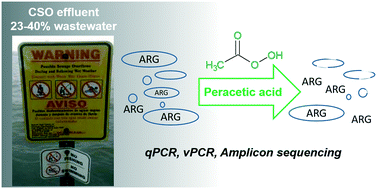当前位置:
X-MOL 学术
›
Environ. Sci.: Water Res. Technol.
›
论文详情
Our official English website, www.x-mol.net, welcomes your
feedback! (Note: you will need to create a separate account there.)
Peracetic acid disinfection kinetics for combined sewer overflows: indicator organisms, antibiotic resistance genes, and microbial community
Environmental Science: Water Research & Technology ( IF 3.5 ) Pub Date : 2017-08-17 00:00:00 , DOI: 10.1039/c7ew00184c Alessia Eramo 1, 2, 3, 4, 5 , William R. Morales Medina 1, 2, 3, 4, 5 , Nicole L. Fahrenfeld 1, 2, 3, 4, 5
Environmental Science: Water Research & Technology ( IF 3.5 ) Pub Date : 2017-08-17 00:00:00 , DOI: 10.1039/c7ew00184c Alessia Eramo 1, 2, 3, 4, 5 , William R. Morales Medina 1, 2, 3, 4, 5 , Nicole L. Fahrenfeld 1, 2, 3, 4, 5
Affiliation

|
Combined sewer overflows (CSOs) degrade water quality and end-of-pipe treatment is one potential solution for retrofitting this outdated infrastructure. The goal of this research was to evaluate peracetic acid (PAA) as a disinfectant for CSOs using viability based molecular methods for antibiotic resistance genes (ARGs), indicator organism marker gene BacHum, and 16S rRNA genes. Simulated CSO effluent was prepared using 23–40% wastewater, representing the higher end of the range of wastewater concentrations reported in CSO effluent. PAA residual following disinfection was greatest for samples with the lowest initial COD. Treatment of simulated CSO effluent (23% wastewater) with 100 mg min L−1 PAA (5 mg L−1 PAA, 20 min) was needed to reduce viable cell sul1, tet(G), and BacHum (1.0 ± 0.63–3.2 ± 0.25-log) while 25 to 50 mg min L−1 PAA (5 mg L−1 PAA, 5–10 min) was needed to reduce viable cell loads (0.62 ± 0.56–1.6 ± 0.08-log) in 40% wastewater from a different municipal treatment plant. Increasing contact time after the initial decrease in viable cell gene copies did not significantly improve treatment. A much greater applied Ct of 1200 mg min L−1 PAA (20 mg L−1 PAA, 60 min) was required for significant log reduction of 16S rRNA genes (3.29 ± 0.13-log). No significant losses of mexB were observed during the study. Data were fitted to a Chick–Watson model and resulting inactivation constants for sul1 and tet(G) > BacHum > 16S rRNA. Amplicon sequencing of the 16S rRNA gene indicated the initial viable and total microbial communities were distinct and that treatment with PAA resulted in marked increases of the relative abundance of select phyla, particularly Clostridia which increased by 1–1.5 orders of magnitude. Results confirm that membrane disruption is a mechanism for PAA disinfection and further treatment is needed to reduce total ARGs in CSO effluent.
中文翻译:

下水道溢流的过氧乙酸消毒动力学:指示生物,抗生素抗性基因和微生物群落
下水道的综合溢流(CSO)降低了水质,管道末端处理是改造这种过时的基础设施的一种潜在解决方案。这项研究的目的是使用基于生存力的抗生素抗性基因(ARGs),指示生物标记基因BacHum和16S rRNA基因的分子方法,评估过氧乙酸(PAA)作为CSO的消毒剂。模拟的CSO废水是使用23-40%的废水制备的,代表了CSO废水中报告的废水浓度范围的上限。消毒后的PAA残留对于初始COD最低的样品最大。需要用100 mg min L -1 PAA(5 mg L -1 PAA,20 min)处理模拟的CSO废水(23%废水),以减少存活的细胞sul 1,tet(G)和BacHum(1.0±0.63–3.2±0.25-log),同时需要25至50 mg / min L -1 PAA(5 mg L -1 PAA,5–10 min)来减少可行的细胞负荷(0.62 ±0.56-1.6±0.08对数)来自不同市政处理厂的40%废水。在最初减少活细胞基因拷贝后增加接触时间并不能显着改善治疗效果。为了显着降低16S rRNA基因的对数减少(3.29±0.13-log),需要更高的1200 mg / min L -1 PAA(20 mg L -1 PAA,60 min)的Ct 。在研究过程中未观察到明显的mex B损失。将数据拟合到Chick-Watson模型,并得出sul 1和tet的失活常数(G)> BacHum> 16S rRNA。16S rRNA基因的扩增子测序表明,最初的存活和总微生物群落是不同的,并且用PAA处理导致所选门的相对丰度显着增加,尤其是梭菌的相对丰度增加了1–1.5个数量级。结果证实,膜破裂是PAA消毒的一种机制,需要进一步处理以减少CSO废水中的总ARG。
更新日期:2017-10-27
中文翻译:

下水道溢流的过氧乙酸消毒动力学:指示生物,抗生素抗性基因和微生物群落
下水道的综合溢流(CSO)降低了水质,管道末端处理是改造这种过时的基础设施的一种潜在解决方案。这项研究的目的是使用基于生存力的抗生素抗性基因(ARGs),指示生物标记基因BacHum和16S rRNA基因的分子方法,评估过氧乙酸(PAA)作为CSO的消毒剂。模拟的CSO废水是使用23-40%的废水制备的,代表了CSO废水中报告的废水浓度范围的上限。消毒后的PAA残留对于初始COD最低的样品最大。需要用100 mg min L -1 PAA(5 mg L -1 PAA,20 min)处理模拟的CSO废水(23%废水),以减少存活的细胞sul 1,tet(G)和BacHum(1.0±0.63–3.2±0.25-log),同时需要25至50 mg / min L -1 PAA(5 mg L -1 PAA,5–10 min)来减少可行的细胞负荷(0.62 ±0.56-1.6±0.08对数)来自不同市政处理厂的40%废水。在最初减少活细胞基因拷贝后增加接触时间并不能显着改善治疗效果。为了显着降低16S rRNA基因的对数减少(3.29±0.13-log),需要更高的1200 mg / min L -1 PAA(20 mg L -1 PAA,60 min)的Ct 。在研究过程中未观察到明显的mex B损失。将数据拟合到Chick-Watson模型,并得出sul 1和tet的失活常数(G)> BacHum> 16S rRNA。16S rRNA基因的扩增子测序表明,最初的存活和总微生物群落是不同的,并且用PAA处理导致所选门的相对丰度显着增加,尤其是梭菌的相对丰度增加了1–1.5个数量级。结果证实,膜破裂是PAA消毒的一种机制,需要进一步处理以减少CSO废水中的总ARG。











































 京公网安备 11010802027423号
京公网安备 11010802027423号